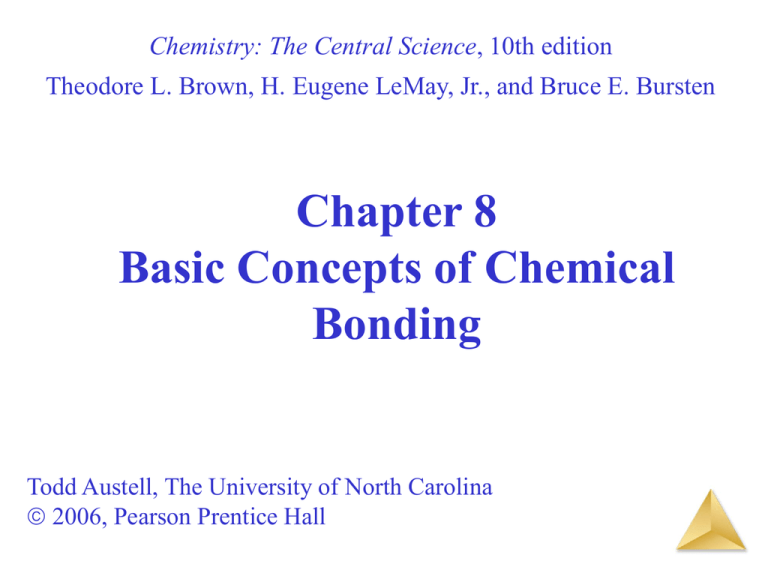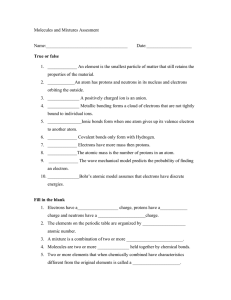
Chemistry: The Central Science, 10th edition
Theodore L. Brown, H. Eugene LeMay, Jr., and Bruce E. Bursten
Chapter 8
Basic Concepts of Chemical
Bonding
Todd Austell, The University of North Carolina
2006, Pearson Prentice Hall
1. -
2. -
3. -
4. -
1. -
2. -
3. -
4. -
1.
2.
3.
4.
Each magnesium atom loses one electron and each
fluorine atom gains two electrons.
Each magnesium atom loses two electrons and each
fluorine atom gains one electron.
Each magnesium atom gains one electron and each
fluorine atom loses two electrons.
Each magnesium atom gains two electrons and each
fluorine atom loses one electron.
1.
2.
3.
4.
Each magnesium atom loses one electron and each
fluorine atom gains two electrons.
Each magnesium atom loses two electrons and each
fluorine atom gains one electron.
Each magnesium atom gains one electron and each
fluorine atom loses two electrons.
Each magnesium atom gains two electrons and each
fluorine atom loses one electron.
1.
2.
3.
4.
Rh
Tc
Ru
Pd
1.
2.
3.
4.
Rh
Tc
Ru
Pd
1.
2.
3.
4.
There are no attractive forces in He2; that’s why it doesn’t
exist.
Attractive forces are between between the two entire
atoms; repulsive forces are only between the electron
clouds.
Attractive forces are between each electron and either
nucleus; repulsive forces are those between the two nuclei
and those between the two electrons.
Attractive forces are between each atom’s two electrons
and between the two nuclei; repulsive forces are those
between the nuclei and the two electrons.
1.
2.
3.
4.
There are no attractive forces in He2; that’s why it doesn’t
exist.
Attractive forces are between between the two entire
atoms; repulsive forces are only between the electron
clouds.
Attractive forces are between each electron and either
nucleus; repulsive forces are those between the two nuclei
and those between the two electrons.
Attractive forces are between each atom’s two electrons
and between the two nuclei; repulsive forces are those
between the nuclei and the two electrons.
1.
2.
3.
The repulsive forces are greater than the attractive
forces.
The attractive and repulsive forces are equal and thus
balance each other out.
The attractive forces are greater than the repulsive
forces.
1.
2.
3.
The repulsive forces are greater than the attractive
forces.
The attractive and repulsive forces are equal and thus
balance each other out.
The attractive forces are greater than the repulsive
forces.
1.
2.
3.
C–O in carbon monoxide is a single bond.
C–O in carbon monoxide is a double bond.
C–O in carbon monoxide is a triple bond.
1.
2.
3.
C–O in carbon monoxide is a single bond.
C–O in carbon monoxide is a double bond.
C–O in carbon monoxide is a triple bond.
1.
2.
3.
4.
EN and EA are the same; they both measure the same
characteristic.
EA measures the energy released when an isolated atom
gains an electron to form a 1– ion; EN measures the ability
of an atom to hold onto its own electrons and attract
electrons from other atoms.
EN values of neutral atoms are just the negative of EA
values of neutral atoms.
EN measures the energy released when an isolated atom
gains an electron to form a 1– ion; EA measures the ability
of an atom to hold onto its own electrons and attract
electrons from other atoms.
1.
2.
3.
4.
EN and EA are the same; they both measure the same
characteristic.
EA measures the energy released when an isolated atom
gains an electron to form a 1– ion; EN measures the ability
of an atom to hold onto its own electrons and attract
electrons from other atoms.
EN values of neutral atoms are just the negative of EA
values of neutral atoms.
EN measures the energy released when an isolated atom
gains an electron to form a 1– ion; EA measures the ability
of an atom to hold onto its own electrons and attract
electrons from other atoms.
1.
2.
3.
nonpolar
polar covalent
ionic
1.
2.
3.
nonpolar
polar covalent
ionic
1.
2.
3.
4.
ClF
IF
They have the same dipole moment.
Neither has a dipole moment; they are both nonpolar.
1.
2.
3.
4.
ClF
IF
They have the same dipole moment.
Neither has a dipole moment; they are both nonpolar.
1.
2.
3.
4.
The large size of the I and the Br make the charge
density less noticeable.
The dipole moments in both HI and HBr are in the
opposite direction of HF and HCl.
Because HI and HBr are both strong acids, less negative
charge forms on the halogens.
In HI and HBr the electronegativity differences are too
small to lead to large charge separations in the
molecules.
1.
2.
3.
4.
The large size of the I and the Br make the charge
density less noticeable.
The dipole moments in both HI and HBr are in the
opposite direction of HF and HCl.
Because HI and HBr are both strong acids, less negative
charge forms on the halogens.
In HI and HBr the electronegativity differences are too
small to lead to large charge separations in the
molecules.
1.
2.
3.
OsO4
MoO3
Both compounds have the same melting point.
1.
2.
3.
OsO4
MoO3
Both compounds have the same melting point.
1.
2.
3.
4.
The structure actually represents an ion.
The F in the structure must have four covalent bonds
attached to it.
There must be another F in the structure carrying a –1
formal charge.
There must be a better Lewis structure since F is not
expected to carry a formal charge of +1, being the most
electronegative element.
1.
2.
3.
4.
The structure actually represents an ion.
The F in the structure must have four covalent bonds
attached to it.
There must be another F in the structure carrying a –1
formal charge.
There must be a better Lewis structure since F is not
expected to carry a formal charge of +1, being the most
electronegative element.
1.
2.
Yes
No
1.
2.
Yes
No
1.
2.
3.
4.
one-and-a-fifth bonds
one-and-a-forth bonds
one-and-a-third bonds
one-and-a-half bonds
1.
2.
3.
4.
one-and-a-fifth bonds
one-and-a-forth bonds
one-and-a-third bonds
one-and-a-half bonds
1.
2.
Yes, because double bonds can be moved to give
equivalent structures.
No, because double bonds cannot be moved to give
equivalent structures due to fixed hydrogens.
1.
2.
Yes, because double bonds can be moved to give
equivalent structures.
No, because double bonds cannot be moved to give
equivalent structures due to fixed hydrogens.
1.
The enthalpy of atomization / 7 bonds broken = a good
estimate of D(CC).
2.
The enthalpy of atomization – 6 · D(CH) = a good
estimate of D(CC).
3.
The enthalpy of atomization + 6 · D(CH) = a good
estimate of D(CC).
The enthalpy of atomization / 7 bonds broken
– 6D(CH) = a good estimate of D(CC).
4.
1.
The enthalpy of atomization / 7 bonds broken = a good
estimate of D(CC).
2.
The enthalpy of atomization – 6 · D(CH) = a good
estimate of D(CC).
3.
The enthalpy of atomization + 6 · D(CH) = a good
estimate of D(CC).
The enthalpy of atomization / 7 bonds broken
– 6D(CH) = a good estimate of D(CC).
4.







